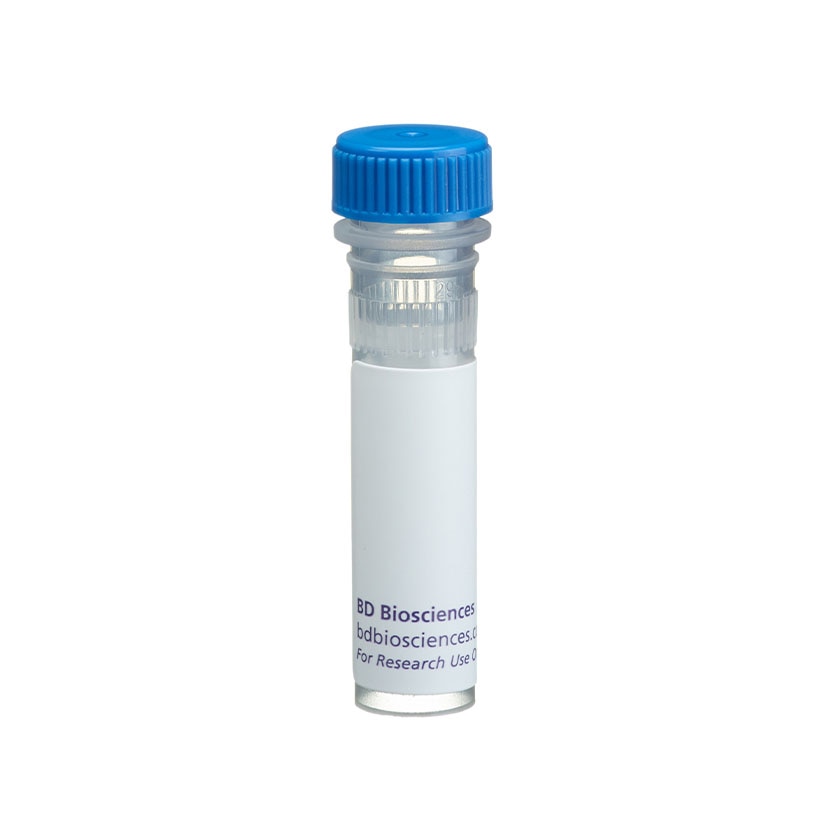Old Browser
This page has been recently translated and is available in French now.
Looks like you're visiting us from {countryName}.
Would you like to stay on the current country site or be switched to your country?




Expression of IL-8 by stimulated CD14+ human monocytes. Human PBMC were stimulated for 6 hours with LPS (10 ng/ml final concentration) in the presence of GolgiStop™ (2 µM final concentration; Cat. No. 554724). The PBMC were harvested, stained with FITC-mouse anti-human CD14 antibody (FITC-M5E2, Cat. No. 555397), fixed, permeabilized, and subsequently stained with 0.25 µg of PE-mouse anti-human IL-8 antibody (PE-G265-8, Cat. No. 554720) following the BD Pharmingen staining protocol (left panel). The data reflect gating on monocytes, based on forward and side scattered light signals. To demonstrate specificity of staining, the binding of PE-G265-8 was blocked by the preincubation of the conjugated antibody with recombinant human IL-8 (0.25 µg, Cat. No. 554609; center panel), and by preincubation of the fixed/permeabilized cells with unlabelled G265-8 antibody (2.5 µg, Cat. No. 554717; right panel) prior to staining with the PE-G265-8 antibody. The quadrant markers for the bivariate dot plots were set based on the autofluorescence control, and verified with the recombinant cytokine blocking (center panel) and unlabelled antibody (right panel) blocking specificity controls.


BD Pharmingen™ Purified Mouse Anti-Human IL-8

Regulatory Status Legend
Any use of products other than the permitted use without the express written authorization of Becton, Dickinson and Company is strictly prohibited.
Preparation And Storage
Recommended Assay Procedures
Blocking Control for Intracellular Staining: The purified G265-8 antibody (Cat. No. 554717) can be used as a blocking control to demonstrate specificity of IL-8 staining by PE-G265-8 antibody (Cat. No. 554720). To perform this control, the fixed/permeabilized cells (~ 1 million) can be incubated with 1-10 µg of unlabeled G265-8 antibody (Cat. No. 554717) for 20 minutes at 4°C, prior to staining with PE-G265-8 antibody (e.g., 0.1 - 0.5 µg mAb/1 million cells). The intracellular cytokine staining technique and use of blocking controls are described in detail by C. Prussin and D. Metcalfe.
ELISA Detection: The biotinylated G265-8 antibody (Cat. No. 554718) is useful as a detection antibody for a sandwich ELISA for measuring human IL-8 protein levels. Biotinylated G265-8 antibody can be paired with the purified G265-5 antibody (Cat. No. 554716) with recombinant human IL-8 (Cat. No. 554609) as the standard. For testing IL-8 in serum or plasma, our human IL-8 OptEIA™ ELISA Set (Cat. No. 555244) and Kit (Cat. No. 550999) are specially formulated and recommended.
Immunofluorescent Staining and Flow Cytometric Analysis: The G265-8 antibody is useful for immunofluorescent staining and flow cytometric analysis to identify and enumerate human IL-8 producing cells within mixed cell populations. The PE-conjugated G265-8 antibody (Cat. No. 554720) is especially suitable for these experiments. For specific methodology, please visit the protocols section or chapter on intracellular staining in the Immune Function Handbook, both of which are posted on our web site, www.bdbiosciences.com.
Immunocytochemical staining: The purified format of G265-8 antibody is useful for ICC staining with a DAB substrate. The Cat. No. 550419 is tested in the ICC application.
Product Notices
- Since applications vary, each investigator should titrate the reagent to obtain optimal results.
- Please refer to www.bdbiosciences.com/us/s/resources for technical protocols.
- IL-8 is protected under U.S. Patent Nos. 5,652,338 and 5,698,196.
- Caution: Sodium azide yields highly toxic hydrazoic acid under acidic conditions. Dilute azide compounds in running water before discarding to avoid accumulation of potentially explosive deposits in plumbing.
The G265-8 monoclonal antibody specifically binds to both the 72 and 77 amino acid isoforms of human Interleukin-8 (IL-8). IL-8 is secreted as an 8-9 kDa, non-glycosylated proinflammatory chemokine protein also known as chemokine (C-X-C motif) ligand 8 (CXCL8). IL-8 is synthesized as a 99 amino acid precursor that is proteolytically processed into several isoforms. The 72 amino acid isoform is produced by monocytes, macrophages, granulocytes, epithelial cells, and fibroblasts in response to pro-inflammatory stimuli including cytokines and microbial agents. It is also expressed by endothelial cells, fibroblasts, keratinocytes, lymphocytes, and a variety of tumor cells. In response to IL-4, IL-10 and TGFβ, the cellular production of IL-8 is inhibited. IL-8 is crucial for the activation and recruitment of neutrophils to inflammatory sites. IL-8 is also a chemoattractant for basophils and T-lymphocytes. IL-8 possesses angiogenic activity and can be associated with tumor angiogenesis and metastasis. The 77 amino acid IL-8 isoform is primarily produced by endothelial cells. This larger isoform is reportedly a less potent neutrophil activator than the 72 amino acid isoform. IL-8 binds to and signals through two G-protein-coupled receptors, IL-8RA (CXCR1/CD181) and IL-8RB (CXCR2/CD182).
Development References (2)
-
Matsushima K, Oppenheim JJ. Interleukin 8 and MCAF: novel inflammatory cytokines inducible by IL 1 and TNF. Cytokine. 1989; 1(1):2-13. (Biology). View Reference
-
Prussin C, Metcalfe DD. Detection of intracytoplasmic cytokine using flow cytometry and directly conjugated anti-cytokine antibodies. J Immunol Methods. 1995; 188(1):117-128. (Methodology). View Reference
Please refer to Support Documents for Quality Certificates
Global - Refer to manufacturer's instructions for use and related User Manuals and Technical data sheets before using this products as described
Comparisons, where applicable, are made against older BD Technology, manual methods or are general performance claims. Comparisons are not made against non-BD technologies, unless otherwise noted.
For Research Use Only. Not for use in diagnostic or therapeutic procedures.
Report a Site Issue
This form is intended to help us improve our website experience. For other support, please visit our Contact Us page.